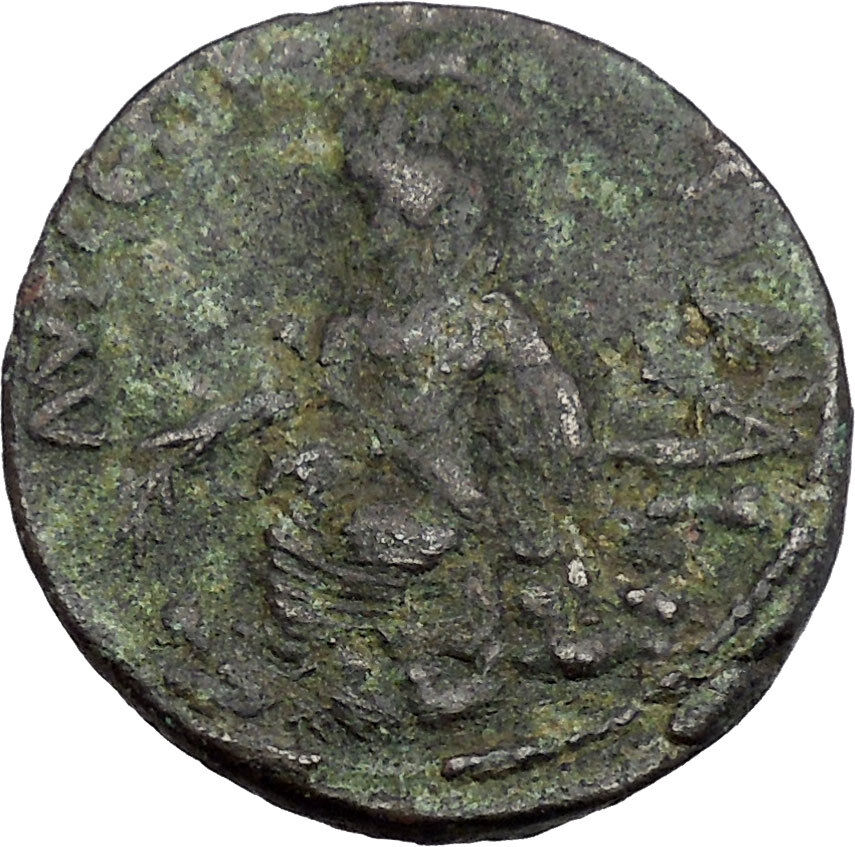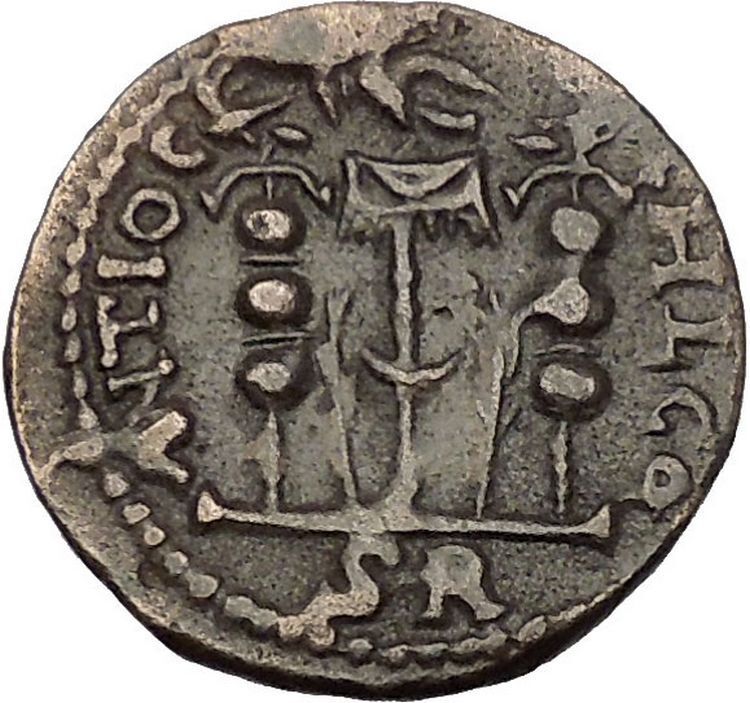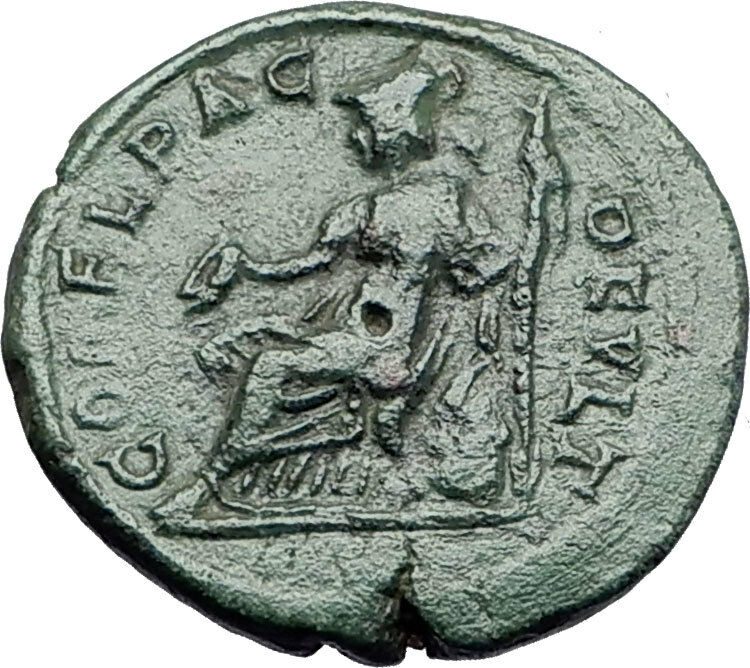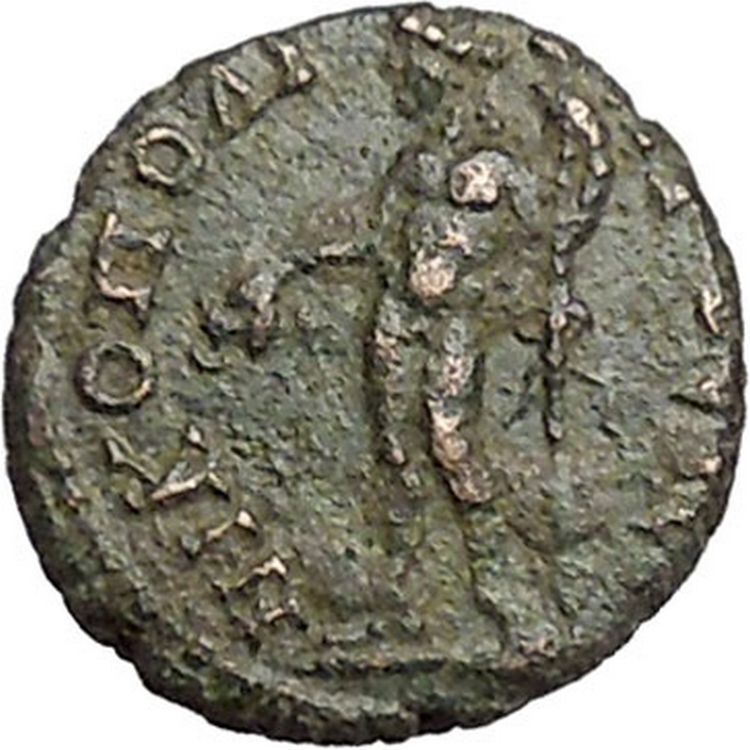|
Gordian III – Roman Emperor: 238-244 A.D.
Bronze 20mm (3.72 grams) from the Roman provincial city of Nicaea
in the province of Bythinia
Reference: SNGCop 526, BMC 114, SGI 3671. –
M ANT ΓOPΔIANOC AV, radiate, draped bust right.
NIKAEΩN, Four legionary standards, two inner ones topped with Capricorns and outer two topped with wreaths.
You are bidding on the exact item pictured, provided with a Certificate of Authenticity and Lifetime Guarantee of Authenticity.
 Capricorn (♑) is the tenth astrological sign in the zodiac, originating from the constellation of Capricornus. It spans the 270-300th degree of the zodiac, corresponding to celestial longitude. Capricorn is ruled by the planet Saturn. Under the tropical zodiac, the sun transits this area from December 22 to January 19 each year, and under the sidereal zodiac, the sun currently transits the constellation of Capricorn from approximately January 15 to February 14. In astrology, Capricorn is considered an earth sign, introvert sign, and one of the four cardinal signs. Capricorn (♑) is the tenth astrological sign in the zodiac, originating from the constellation of Capricornus. It spans the 270-300th degree of the zodiac, corresponding to celestial longitude. Capricorn is ruled by the planet Saturn. Under the tropical zodiac, the sun transits this area from December 22 to January 19 each year, and under the sidereal zodiac, the sun currently transits the constellation of Capricorn from approximately January 15 to February 14. In astrology, Capricorn is considered an earth sign, introvert sign, and one of the four cardinal signs.
Zodiac symbol Goat Duration (tropical, western) 22 December – 20 January (2014, UTC) Constellation Capricornus Zodiac element Earth Zodiac quality Cardinal Sign ruler Saturn Detriment Moon Exaltation Mars Fall Jupiter
Capricorn-Sagittarius cusps (those born from December 22 to December 28) are considered to be slightly different from the typical Capricorn, being more outgoing, jovial and less ambitious and money-orientated than the Capricorn who is not born on a cusp.
 Nicaea or Nicea was an ancient city in northwestern Anatolia, and is primarily known as the site of the First and Second Councils of Nicaea (the first and seventh Ecumenical councils in the early history of the Christian Church), the Nicene Creed (which comes from the First Council), and as the capital city of the Empire of Nicaea following the Fourth Crusade in 1204, until the recapture of Constantinople by the Byzantines in 1261. Nicaea or Nicea was an ancient city in northwestern Anatolia, and is primarily known as the site of the First and Second Councils of Nicaea (the first and seventh Ecumenical councils in the early history of the Christian Church), the Nicene Creed (which comes from the First Council), and as the capital city of the Empire of Nicaea following the Fourth Crusade in 1204, until the recapture of Constantinople by the Byzantines in 1261.
The ancient city is located within the modern Turkish city of İznik (whose modern name derives from Nicaea’s), and is situated in a fertile basin at the eastern end of Lake Ascanius, bounded by ranges of hills to the north and south. It is situated with its west wall rising from the lake itself, providing both protection from siege from that direction, as well as a source of supplies which would be difficult to cut off. The lake is large enough that it could not be blockaded from the land easily, and the city was large enough to make any attempt to reach the harbour from shore-based siege weapons very difficult.
The ancient city is surrounded on all sides by 5 kilometres (3 mi) of walls about 10 metres (33 ft) high. These are in turn surrounded by a double ditch on the land portions, and also included over 100 towers in various locations. Large gates on the three landbound sides of the walls provided the only entrance to the city.
Today the walls have been pierced in many places for roads, but much of the early work survives and, as a result, it is a major tourist destination.
Early history
The place is said to have been colonized by Bottiaeans, and to have originally borne the name of Ancore (Ἀγκόρη) or Helicore (Ἑλικόρη), or by soldiers of Alexander the Great’s army who hailed from Nicaea in Locris, near Thermopylae. The later version however was not widespread even in Antiquity. Whatever the truth, the first Greek colony on the site was probably destroyed by the Mysians, and it fell to Antigonus I Monophthalmus, one of Alexander’s successors (Diadochi) to refound the city ca. 315 BC as Antigoneia (Ἀντιγονεία) after himself. Antigonus is also known to have established Bottiaean soldiers in the vicinity, lending credence to the tradition about the city’s founding by Bottiaeans. Following Antigonus’ defeat and death at the Battle of Ipsus in 301 BC, the city was captured by Lysimachus, who renamed it Nicaea (Νίκαια, also transliterated as Nikaia or Nicæa; see also List of traditional Greek place names), in tribute to his wife Nicaea, who had recently died.
Sometime before 280 BC, the city came under the control of the local dynasty of the kings of Bithynia. This marks the beginning of its rise to prominence as a seat of the royal court, as well as of its rivalry with Nicomedia. The two cities’ dispute over which one was the pre-eminent city (signified by the appellation metropolis) of Bithynia continued for centuries, and the 38th oration of Dio Chrysostom was expressly composed to settle the dispute.
Roman period
Along with the rest of Bithynia, Nicaea came under the rule of the Roman Republic in 72 BC. The city remained one of the most important urban centres of Asia Minor throughout the Roman period, and continued its old competition with Nicomedia over pre-eminence and the location of the seat of the Roman governor of Bithynia et Pontus. The geographer Strabo (XII.565 ff.) described the city as built in the typical Hellenistic fashion with great regularity, in the form of a square, measuring 16 stadia in circumference, i.e. approx. 700 m × 700 m (2,297 ft × 2,297 ft) or 0.7 km × 0.7 km (0.43 mi × 0.43 mi) covering an area of some 50 ha (124 acres) or 0.5 km2 (0.2 sq mi); it had four gates, and all its streets intersected one another at right angles in accordance with the Hippodamian plan, so that from a monument in the centre all the four gates could be seen. This monument stood in the gymnasium, which was destroyed by fire but was restored with increased magnificence by Pliny the Younger, when he was governor there in the early 2nd century AD. In his writings Pliny makes frequent mention of Nicaea and its public buildings.
Emperor Hadrian visited the city in 123 AD after it had been severely damaged by an earthquake and began to rebuild it. The new city was enclosed by a polygonal wall of some 5 kilometres in length. Reconstruction was not completed until the 3rd century, and the new set of walls failed to save Nicaea from being sacked by the Goths in 258 AD. The numerous coins of Nicaea which still exist attest the interest taken in the city by the Roman emperors, as well as its attachment to the rulers; many of them commemorate great festivals celebrated there in honour of gods and emperors, as Olympia, Isthmia, Dionysia, Pythia, Commodia, Severia, Philadelphia, etc.
Byzantine period
By the 4th century, Nicaea was a large and prosperous city, and a major military and administrative centre. Emperor Constantine the Great convened the First Ecumenical Council there, and the city gave its name to the Nicene Creed. The city remained important in the 4th century, seeing the proclamation of Emperor Valens (364) and the failed rebellion of Procopius (365). During the same period, the See of Nicaea became independent of Nicomedia and was raised to the status of a metropolitan bishopric. However, the city was hit by two major earthquakes in 363 and 368, and coupled with competition from the newly established capital of the Eastern Empire, Constantinople, it began to decline thereafter. Many of its grand civic buildings began to fall into ruin, and had to be restored in the 6th century by Emperor Justinian I.
The city disappears from sources thereafter and is mentioned again in the early 8th century: in 715, the deposed emperor Anastasios II fled there, and the city successfully resisted attacks by the Umayyad Caliphate in 716 and 727. The city was again damaged by an earthquake in 740, served as the base of the rebellion of Artabasdos in 741/2, and served as the meeting-place of the Seventh Ecumenical Council, which condemned Byzantine Iconoclasm, in 787 (the council probably met in the basilica of Hagia Sophia). Nicaea became the capital of the Opsician Theme in the 8th century and remained “a center of administration and trade” (C. Foss). A Jewish community is attested in the city in the 10th century. Due to its proximity to Constantinople, the city was contested in the rebellions of the 10th and 11th centuries as a base from which to threaten the capital. It was in the wake of such a rebellion, that of Nikephoros Melissenos, that it fell into the hands of Melissenos’ Turkish allies in 1081. The Seljuk Turks made Nicaea the capital of their possessions in Asia Minor until 1097, when it returned to Byzantine control with the aid of the First Crusade after a long siege.
The 12th century saw a period of relative stability and prosperity at Nicaea. The Komnenian emperors Alexios, John and Manuel campaigned extensively to strengthen the Byzantine presence in Asia Minor. Major fortifications were constructed across the region, especially by John and Manuel, which helped to protect the city and its fertile hinterland. There were also several military bases and colonies in the area, for example the one at Rhyndakos in Bithynia, where the emperor John spent a year training his troops in preparation for campaigns in southern Asia Minor.
After the fall of Constantinople to the Fourth Crusade in 1204, and the establishment of the Latin Empire, Nicaea escaped Latin occupation and maintained an autonomous stance. From 1206 on, it became the base of Theodore Laskaris, who in 1208 was crowned emperor there and founded the Empire of Nicaea. The Patriarchate of Constantinople, exiled from Constantinople, also took up residence in the city until the recapture of Constantinople in 1261. Although Nicaea was soon abandoned as the primary residence of the Nicaean emperors, who favoured Nymphaion and Magnesia on the Maeander, the period was a lively one in the city’s history, with “frequent synods, embassies, and imperial weddings and funerals”, while the influx of scholars from other parts of the Greek world made it a centre of learning as well.
After the restoration of the Byzantine Empire in 1261, the city once again declined in importance. The neglect of the Asian frontier by Michael VIII Palaiologos provoked a major uprising in 1262, and in 1265, panic broke out when rumours circulated of an imminent Mongol attack. Emperor Andronikos II Palaiologos visited the city in 1290 and took care to restore its defences, but Byzantium proved unable to halt the rise of the nascent Ottoman emirate in the region. After Emperor Andronikos III Palaiologos and John Kantakouzenos were defeated at Pelekanon on 11 June 1329, the Byzantine government could no longer defend Nicaea. Nicaea finally surrendered to the Ottomans after a long siege 2 March 1331.
Gordian III – Roman Emperor: 238-244 A.D.
Caesar: 238 A.D. (under Balbinus and Pupienus)
Augustus: 238-244 A.D.
| Grandson of Gordian I | Nephew of Gordian II | Adopted Successor of Balbinus and Pupienus | Husband of Tranquillina |
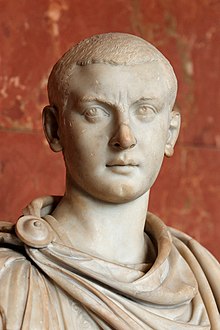
Gordian III (Latin: Marcus Antonius Gordianus Pius Augustus; 20 January 225 AD – 11 February 244 AD) was Roman Emperor from 238 AD to 244 AD. At the age of 13, he became the youngest sole legal Roman emperor throughout the existence of the united Roman Empire. Gordian was the son of Antonia Gordiana and an unnamed Roman Senator who died before 238. Antonia Gordiana was the daughter of Emperor Gordian I and younger sister of Emperor Gordian II. Very little is known of his early life before his acclamation. Gordian had assumed the name of his maternal grandfather in 238 AD.
In 235, following the murder of Emperor Alexander Severus in Moguntiacum (modern Mainz), the capital of the Roman province Germania Superior, Maximinus Thrax was acclaimed Emperor. In the following years, there was a growing opposition against Maximinus in the Roman senate and amongst the majority of the population of Rome. In 238 a rebellion broke out in the Africa Province, where Gordian’s grandfather and uncle, Gordian I and II, were proclaimed joint emperors. This revolt was suppressed within a month by Cappellianus, governor of Numidia and a loyal supporter of Maximinus Thrax. The elder Gordians died, but public opinion cherished their memory as peace-loving and literate men, victims of Maximinus’ oppression.
Meanwhile, Maximinus was on the verge of marching on Rome and the Senate elected Pupienus and Balbinus as joint emperors. These senators were not popular men and the population of Rome was still shocked by the elder Gordian’s fate, so the Senate decided to take the teenager Gordian, rename him Marcus Antonius Gordianus like his grandfather, and raise him to the rank of Caesar and imperial heir. Pupienus and Balbinus defeated Maximinus, mainly due to the defection of several legions, particularly the II Parthica, who assassinated Maximinus. However, their joint reign was doomed from the start with popular riots, military discontent and an enormous fire that consumed Rome in June 238. On July 29, Pupienus and Balbinus were killed by the Praetorian Guard and Gordian proclaimed sole emperor.
Rule
Due to Gordian’s age, the imperial government was surrendered to the aristocratic families, who controlled the affairs of Rome through the Senate. In 240, Sabinianus revolted in the African province, but the situation was quickly brought under control. In 241, Gordian was married to Furia Sabinia Tranquillina, daughter of the newly appointed praetorian prefect, Timesitheus. As chief of the Praetorian Guard and father in law of the Emperor, Timesitheus quickly became the de facto ruler of the Roman Empire.
In the 3rd century, the Roman frontiers weakened against the Germanic tribes across the Rhine and Danube, and the Sassanid Empire across the Euphrates increased its own attacks. When the Persians under Shapur I invaded Mesopotamia, the young emperor opened the doors of the Temple of Janus for the last time in Roman history, and sent a large army to the East. The Sassanids were driven back over the Euphrates and defeated in the Battle of Resaena (243). The campaign was a success and Gordian, who had joined the army, was planning an invasion of the enemy’s territory, when his father-in-law died in unclear circumstances. Without Timesitheus, the campaign, and the Emperor’s security, were at risk.
Gaius Julius Priscus and, later on, his own brother Marcus Julius Philippus, also known as Philip the Arab, stepped in at this moment as the new Praetorian Prefects and the campaign proceeded. Around February 244, the Persians fought back fiercely to halt the Roman advance to Ctesiphon. Persian sources claim that a battle occurred (Battle of Misiche) near modern Fallujah (Iraq) and resulted in a major Roman defeat and the death of Gordian III. Roman sources do not mention this battle and suggest that Gordian died far away from Misiche, at Zaitha (Qalat es Salihiyah) in northern Mesopotamia. Modern scholarship does not unanimously accept this course of the events. One view holds that Gordian died at Zaitha, murdered by his frustrated army, while the role of Philip is unknown. Other scholars, such as Kettenhofen, Hartman and Winter have concluded that Gordian died in battle against the Sassanids.
Philip transferred the body of the deceased emperor to Rome and arranged for his deification. Gordian’s youth and good nature, along with the deaths of his grandfather and uncle and his own tragic fate at the hands of the enemy, earned him the lasting esteem of the Romans. The soldiers held Gordian in high esteem, as he had possibly sacrificed his life to save them in 244.
|





 Capricorn (♑) is the tenth astrological sign in the zodiac, originating from the constellation of Capricornus. It spans the 270-300th degree of the zodiac, corresponding to celestial longitude. Capricorn is ruled by the planet Saturn. Under the tropical zodiac, the sun transits this area from December 22 to January 19 each year, and under the sidereal zodiac, the sun currently transits the constellation of Capricorn from approximately January 15 to February 14. In astrology, Capricorn is considered an earth sign, introvert sign, and one of the four cardinal signs.
Capricorn (♑) is the tenth astrological sign in the zodiac, originating from the constellation of Capricornus. It spans the 270-300th degree of the zodiac, corresponding to celestial longitude. Capricorn is ruled by the planet Saturn. Under the tropical zodiac, the sun transits this area from December 22 to January 19 each year, and under the sidereal zodiac, the sun currently transits the constellation of Capricorn from approximately January 15 to February 14. In astrology, Capricorn is considered an earth sign, introvert sign, and one of the four cardinal signs. Nicaea or Nicea was an ancient city in northwestern Anatolia, and is primarily known as the site of the First and Second Councils of Nicaea (the first and seventh Ecumenical councils in the early history of the Christian Church), the Nicene Creed (which comes from the First Council), and as the capital city of the Empire of Nicaea following the Fourth Crusade in 1204, until the recapture of Constantinople by the Byzantines in 1261.
Nicaea or Nicea was an ancient city in northwestern Anatolia, and is primarily known as the site of the First and Second Councils of Nicaea (the first and seventh Ecumenical councils in the early history of the Christian Church), the Nicene Creed (which comes from the First Council), and as the capital city of the Empire of Nicaea following the Fourth Crusade in 1204, until the recapture of Constantinople by the Byzantines in 1261.


